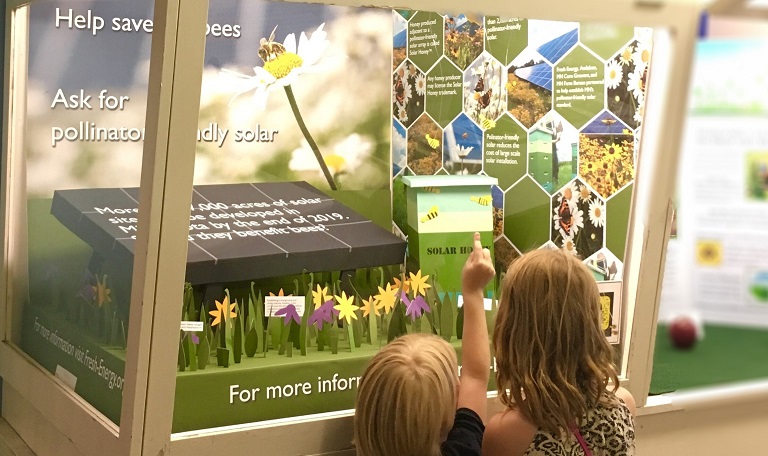
Solar is blooming in Minnesota—and as ground-mounted solar sites spring up around the state, most include an important feature: pollinator habitat. Beekeepers are jumping on the opportunity.
A vital opportunity to create habitat
Bees, monarchs, and other critical pollinators are disappearing, and scientists agree that loss of habitat is a primary cause. With more than 4,500 acres of ground-mounted solar in process or slated for development in 2017, Minnesota has an opportunity to establish habitat equivalent to more than 2.5 million homes each having a six-foot-by-twelve-foot backyard pollinator garden.
Because the U.S. solar industry first took off in the desert Southwest, a standard practice for the land on solar sites is gravel and/or monocrop lawn grass. That changed in 2016 when Fresh Energy, Audubon Minnesota, Minnesota Corn Growers Association, and Minnesota Farmers Union worked with agricultural and business leaders to establish the nation’s first statewide standard for vegetation on solar sites.
The United Kingdom has had long and well-documented success using pollinator habitat on solar sites, with proven reductions in operations and management costs compared to mowing turfgrass, and increases in abundance of bees and other insects needed to pollinate crops.
A Sweet Success
An educational display about pollinator-friendly solar is featured prominently this year in the Agriculture/Horticulture Building at the Minnesota State Fair—the nation’s largest with 1.9 million visitors over 12 days. And attendees can do more than learn—there’s an opportunity to taste!
Inspired by England’s sweet success with “solar farm honey,” pollinator-friendly solar arrays aren’t just benefiting native bees—some arrays are also being co-located with honeybee hives.
National Geographic and Martha Stewart have also weighed in to recognize and celebrate the opportunity to productively use the ground under and around solar arrays.
Minnesota: A National Leader
Throughout the growing season multiple Minnesota solar sites are being planted with black-eyed susans, purple prairie clover, partridge pea, butterfly weed, and more plants selected specially for our climate and pollinator value.
As reported by Solar Power World, integrity and standards like the one established in Minnesota are critical when promoting solar site vegetation as beneficial to pollinators. Too often, we see arbitrary labels that mislead consumers. Thanks to the policy secured by Fresh Energy, Audubon, Minnesota Corn Growers Association, Minnesota Farmers Union and diverse state interests, we will not face arbitrary standards here.
“We’re not talking about just a narrow row of native vegetation by the front gate that makes it look like a project is pollinator-friendly,” said SoCore Energy’s Laura Caspari. “Just putting a row of pretty plants along the front fence doesn’t achieve that. That’s why the Minnesota standard is so important, because it provides a benchmark.”
Spreading the word
Fresh Energy and Audubon will be continuing to engage with states around the country interested in securing their own pollinator-friendly solar definition. As prominent agriculture and conservation leaders wrote in GreenBiz:
Vetted by several of the nation’s top entomologists, these standards play an important role in making sure that when a site is promoted as beneficial to pollinators, that it delivers on those commitments.
Fresh Energy’s Rob Davis (don’t call him the bee man) has been leading pollinator-friendly solar work throughout the country including trainings hosted by the U.S. Department of Energy’s National Renewable Energy Lab and the U.S. Department of Interior’s National Conservation Training Service. See him at VERGE in Santa Clara on Sept. 19.

